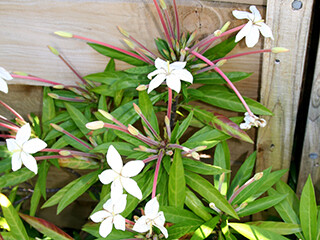If you’re looking to immerse yourself in the wonder of nature, a botanical garden may be just what you’re looking for. Vibrant paths of beautiful green foliage and exotic flowers will have you feeling as though you are walking through a tropical wonderland.
To ensure we provide an unparalleled experience to each visitor, Selby’s botanical researchers have traveled to some of the world’s most wild and remote tropical rainforests to collect thousands of plants, including rare species. Below are a few highlights that were collected while in Belize, a beautiful country located in Central America.
 Epidendrum nocturnum
Epidendrum nocturnum
Collected in Belize, 2014
The Epidendrum nocturnum, also known as the "Nocturnal Epidendrum" is an elegant orchid that is only fragrant during the evening. When we collected this plant, it was not in flower but knew it was an orchid—orchids often have distinctive fleshy leaves and white roots. Flowers are important in identifying an orchid’s species so to confirm its identity, we brought it back to our greenhouse and waited for it to bloom.
 Psychotria poeppig
Psychotria poeppig
Collected in Belize, 2001
Psychotria poeppigiana, also known as Hot Lips is a medium sized shrub with very small yellow flowers that are framed by two glossy, bright red bracts that look like a pair of pouting lips, hence its common name. Hot Lips grows profusely in the wild but is rare in cultivation. Selby Gardens horticulturists have been successful at propagating this species and we have shared it with many other botanical gardens. Hot Lips has a permanent home in our Tropical Conservatory.
 Deherainia smaragdina
Deherainia smaragdina
Collected in Belize, 1997
At first glance, the Deherainia smaragdina may look like many other shrubs but a closer look reveals beautiful foliage, brown velvety stems and emerald green flowers that when in bloom, exude an unusual order similar to stinky cheese—many refer to it as the “stinky foot plant”. Known in cultivation at only a few European botanical gardens, this species is extremely rare outside of its native range of southern Mexico, Guatemala, Belize, and Honduras.
![]() Heliconia aurantiaca
Heliconia aurantiaca
Collected in Belize, 2001
Related to bananas, cannas and gingers, this charming evergreen perennial resembles the bird’s of paradise. What most people would call the ‘flowers’ are actually a group of colorful specialized leaves, called bracts. The true flowers are clear orange and yellow flowers are fairly insignificant and hidden inside these bracts. This plant was collected during a 2001 expedition to Belize, Cayo District, along the Raspaculo River.
 Cryosophila stauracantha
Cryosophila stauracantha
Collected in Belize, 2001
The slim trunk of the Cryosophila stauracantha, also known as the Rootspine Palm is covered with large sharp spines (hence the name) to keep animals away. The fronds of this medium sized palmate palm are dark green with a beautiful silver underside. This palm holds a special place in the heart of Selby, as it was grown from a seed back in 2001, after being collected in the Cayo District, along the Macal River.
 Louteridium donnell-smithii
Louteridium donnell-smithii
Collected Belize, 1997
Most visitors to Selby Gardens won’t ever see this plant in flower, unless they arrive after dark or before dawn since it is strictly night-blooming. A keen observer to the pergola area in the morning (located right outside the Tropical Conservatory), will find its fallen flowers at the base of the plant. Known as "Carretón" in Spanish, the flowers of this plant attract bats, nectar-sipping bats, that is. Rare in cultivation, this plant grows vigorously, producing large, velvety leaves at Selby Gardens.
 Senna hayesiana
Senna hayesiana
Collected in Belize, 2001
Our collection of Columnea sulphurea is so distinct that it earned the cultivar name ‘Selby’ for its leaves that are uniformly purple on the lower surface. It was collected in Belize during an expedition to inventory the flora of the Maya Mountains, the highest mountain range in Belize (1,100 m elev.). The yellow flowers are visited by hummingbirds. The species is known in nature only from the mountains of southern Mexico, Guatemala, and Belize.
 Lindenia rivalis
Lindenia rivalis
Collected in Belize, 2001
The Lindenia rivalis is a rare exotic shrub, known for its long tubular flowers that flair into beautiful white clusters…hence its common name, Needle Flower. It is a prolific bloomer, which made it ideal to bring back for display along Palm Ave. This plants main pollinator is the hawkmoth. We found it growing along stream beds of the Raspaculo River in Belize.
Come see our ever changing display of exotic plants and for more information or ways to support the field expeditions conducted by the botanical researchers at Selby Gardens, contact Bruce Holst, Director of Botany at 941.366.5731, ext. 312 or bholst@s33944.p20.sites.pressdns.com.
